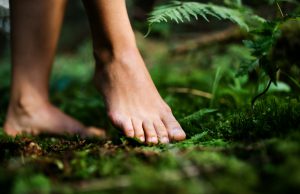Discover the science-backed benefits of grounding and 4 simple ways to start your practice
There was a time when humans were one with nature. They spent time outdoors, lived off the land, and played in the grass, under the broad, blue sky, running barefoot. But technology has steadily moved into human lives, removing them from the earth that once nourished them. Life is supposedly easier, but is it really?

Now people go to the grocery store instead of growing their own food. People flip a light switch instead of kindling a fire. Humans stay at home and access the internet instead of going to the library and searching for real books they can hold in their hands.
Yes, life is easier, but what have we lost? Henry David Thoreau asked the same question, and today we are even farther removed from nature. Grounding – also known as earthing – just might be the answer.
What exactly is grounding?
In one sense, grounding means a return to basics. In another, it is the exposure to nature – the practice of making direct contact with bare feet or hands to the earth’s surface. Of course, a grounding system can also be used, but purists tend to favor the skin-to-earth contact that traditional earthing is known for.
What is truly remarkable about the practice of grounding is that its benefits have been touted by people worldwide. It is a global practice recognized all over the world for its health benefits and the boost it gives to a person’s psychical, physical, and spiritual well-being.
What does science say about grounding?
At this time, earthing is a very under-researched practice. The valid, substantive scientific studies on the benefits of grounding are somewhat sparse, but the research that is out there is mostly positive and shows it as a viable solution to support heart health, relieve chronic pain, reduce inflammation, ease muscle aches, and stabilize mood.
A 2015 study by James L Oschman, Gaétan Chevalier, and Richard Brown found that earthing has an immediate and direct effect on the living matrix that is the central connector for living cells. The electrical conductivity is an integral part of the matrix and functions as a defense mechanism for the immune system, much like antioxidants do. The researchers conclude that grounding restores the body’s natural defenses.
Another study published in 2013 explored the connection between heart health and grounding. Ten healthy participants used patches on the soles of their feet and palms of their hands to the ground. The researchers took blood measurements before the participants grounded and after to see how red blood cell fluidity modified. This is an important factor in heart health. The results showed that after earthing, the participants had significantly fewer red blood cell clumping, which benefits cardiovascular health.
There are many impressive health benefits of grounding, including:
- decreased pain
- improved sleep
- decreased anxious feelings
- improved cortisol rhythm
- decreased sadness
- reduced inflammation
- improved wound healing
- mood stability
- increased heart rate variability
- decreased stress response
- more efficient and effective relaxation
- reduced blood viscosity
Grounding’s whole body benefits make it an attractive drug-free approach to overall wellness.
Here is how to start benefiting from this practice
It is very easy to start grounding and begin reaping its many benefits.
– Go barefoot:
Take off your shoes and walk on the grass, in the mud, or the sand. Let your skin touch the natural surface of the ground to allow for maximum absorption of grounding energy.
– Lie on the ground:
Lying in the grass or on the sand – or anywhere that is a natural surface of the earth – can have remarkable regenerative properties. As long as your skin is making contact with the earth, you reap the benefits.
– Submerse in water:
Water is another good vehicle for grounding. As with natural physical earth, seek out a natural body of water like a lake, brook, or the ocean, and wade in it.
– Use grounding equipment:
If you cannot ground yourself by connecting with the natural earth, you have alternatives. One way to ground when direct grounding is not possible is to use a metal rod that reaches the natural ground outside and is connected to your body via a wire. If the rod and wire method is not possible, other types of equipment are available – including special socks, mats, bands, sheets, patches, and blankets – developed specifically for this practice.
What makes grounding so attractive is that you can start right away without investing any money, purchasing any equipment, or joining a gym or group. Instead, you just walk outside and begin. If you do this, for at least 45 minutes or more, you will experience a positive effect immediately.
yogaesoteric
June 8, 2022
